 ?Mathematical formulae have been encoded as MathML and are displayed in this HTML version using MathJax in order to improve their display. Uncheck the box to turn MathJax off. This feature requires Javascript. Click on a formula to zoom.
?Mathematical formulae have been encoded as MathML and are displayed in this HTML version using MathJax in order to improve their display. Uncheck the box to turn MathJax off. This feature requires Javascript. Click on a formula to zoom.Abstract
The aim of this paper was to investigate the effects of soybean oil, an oilseed rich in the polyunsaturated fatty acid C18:2, on dry matter intake (DMI), milk yield (MY) and milk composition (including fatty acid profile) of dairy cows by using a meta-analysis approach. In the meta-analysis, effect size for all outcomes was reported as standardised means difference with 95% confidence intervals. Q test and I2 were calculated to detect the heterogeneity, with a meta-regression also used to investigate sources of heterogeneity. Results of the meta-analysis indicated that adding soybean oil to the diet of dairy cows decreased DMI, milk fat percentage (MFP), milk fat yield (MFY) and milk protein percentage (MPP), whilst significantly increasing MY. Unsaturated fatty acids C18:2, C18:1 trans-11 and C18:2 cis-9 trans-11 conjugated linoleic acid (CLA) all significantly increased with soybean oil inclusion in the diet, whereas C18:3 was numerically higher but not significantly different. Milk composition, including MFP, MFY, MPP, short-chain and medium-chain fatty acids (C4–C20) and unsaturated fatty acids showed a significant percentage of heterogeneity. Results of the meta-regression indicated that dose of soybean oil, total fatty acids in the diet, and the concentration of C18:2 between groups receiving soybean oil and control are the most important factors affecting this heterogeneity. By performing meta-analysis and meta-regression it can be concluded that dietary supplementation of soybean oil to lactating dairy cows decreased DMI, and increased MY and the amount of unsaturated fatty acids in milk.
Soybean oil dietary supplementation to dairy cows increased milk yield but reduced milk fat content.
Milk fat in soybean oil dietary supplemented cows has a lower content of short-chain fatty acids, associated with de novo synthesis.
Milk fat in soybean oil dietary supplemented cows has a higher content of C18:1 trans-11, C18:2 and CLA.
Highlights
Keywords:
Introduction
Nutrition plays an important role in human health with significant interest shown towards the composition of animal-based products, including dairy, in certain diseases such as: cancer, cardiovascular disease and diabetes (Contò et al. Citation2017). Studies have shown that the presence of saturated fatty acids C14 and C16, as well as certain trans fatty acids (trans isomers of C18:1) increase the risk of cardiovascular disease. However, Siri-Tarino et al. (Citation2010) reported in a meta-analysis study that there is no significant evidence for concluding that dietary saturated fat is associated with an increased risk of cardiovascular disease. Conversely, other fatty acids have been shown to have beneficial effects for human health, e.g. mono- and polyunsaturated fatty acids and certain trans fatty acids such as conjugated linoleic acid (CLA cis-9 trans-11, Givens Citation2010; Shingfield et al. Citation2013). CLA refers to the local and geometric isomers of linoleic fatty acids, which within milk 82% are the isomer cis-9 trans-11 (Dhiman et al. Citation2000). Therefore, increasing the composition of these beneficial fatty acids (unsaturated fatty acids and CLA) in dairy products would be advantageous to improve product quality (Dhiman et al. Citation2000). Changes in the fatty acid profile of milk to improve its therapeutic properties have been highly researched over the last few decades. It has been proven that nutritional manipulations can increase the content of CLA in meat and milk, including certain forages, fish oil and oilseeds (Kliem and Shingfield Citation2016). Oilseeds, such as: soybean (Glycine max), flaxseed (Linum usitatissimum) and safflower (Carthamus tinctorius, (Hiller Citation2014)), are rich in unsaturated fatty acids and have been supplemented in the basal ration of dairy cows in many different forms, e.g. whole grains, extruded grains, free oil or protected oil (Kliem and Shingfield Citation2016). Among the oils, the use of soybean oil rich in C18:2 (linoleic acid) has received much attention with variable results across studies.
Soybean oil has been shown to reduce DMI in several studies (Abel-Caines et al. Citation1998; Bu et al. Citation2007; AlZahal et al. Citation2008; Barletta et al. Citation2016), whereas Dhiman et al. (Citation2000) reported that up to 2% soybean oil does not reduce DMI in dairy cows. Milk yield has been shown to be increased with the addition of soybean oil in dairy cows (Bu et al. Citation2007; AlZahal et al. Citation2008; Fatahnia et al. Citation2008; Ye et al. Citation2009), whereas Huang et al. (Citation2008) and Barletta et al. (Citation2016) reported a decline in milk yield with supplementation. The results with respect to milk fat have shown that supplementation with soybean oil caused a significant reduction in milk fat percentage compared to the control group in the studies of Dhiman et al. (Citation2000), Jenkins et al. (Citation1996), Ye et al. (Citation2009) and Zheng et al. (Citation2005), whereas in other studies the differences were not significant compared to the control group (Abel-Caines et al. Citation1998; Bu et al. Citation2007; AlZahal et al. Citation2008). For other milk components, such as proteins and lactose, the results of the experiments have also been inconsistent (Dhiman et al. Citation2000; Zheng et al. Citation2005; Bu et al. Citation2007; Ye et al. Citation2009). The profile of fatty acids in milk in these studies have also shown inconsistent results, for example Abel-Caines et al. (Citation1998) and Ye et al. (Citation2009) show a reduced level of linoleic acid (C18:2), whereas AlZahal et al. (Citation2008), Bu et al. (Citation2007), Huang et al. (Citation2008) and Jenkins et al. (Citation1996) show an increase and Vargas-Bello-Pérez et al. (Citation2015) and Fatahnia et al. (Citation2008) reported no difference. Finally, Dhiman et al. (Citation2000) found an increase in C18:2 only with levels of soybean oil above 4% DM. In relation to the effect of soybean oil on C18:3 (Linolenic acid) Abel-Caines et al. (Citation1998), Barletta et al. (Citation2016), Bu et al. (Citation2007) and Dhiman et al. (Citation2000) showed no change, whereas Huang et al. (Citation2008) showed a decrease and AlZahal et al. (Citation2008) observed an increase in milk content. The cis-9 trans-11 isomer of CLA was shown to increase in the studies of Bu et al. (Citation2007), Zheng et al. (Citation2005) and Ye et al. (Citation2009), whereas Barletta et al. (Citation2016) observed no change when supplementation soybean oil into the ration of dairy cows.
Meta-analysis is a statistical tool to combine the results of different studies and compile them statistically (Sutton and Higgins Citation2008). The purpose of this study was to use a meta-analysis approach to determine the effect of soybean oil supplementation on MY, DMI, milk composition and fatty acid profile in lactating dairy cows and then further examine the reasons for the heterogeneity of responses observed using meta-regression.
Materials and methods
Literature search
Literature searches were performed through databases of Google Scholar (http://scholar.google.com) and ISI Web of Knowledge (http://wokinfo.com). The publication period of studies was from January 1990 to December 2016. The keywords used to search relevant studies included: soybean oil and milk and fatty acid profile and dairy cow. To ensure collection of all the relevant articles for the meta-analysis, references of articles collected were evaluated and inter library loans or correspondence directly with authors used to access literature not found within the database search. The total number of identified articles was 137, with all articles initially screened for acceptability by determining if the research conducted studied effects of soybean oil in dairy cow nutrition and included the impact on milk production and composition. After discarding papers that did not match the research area, an initial data set of 31 papers was achieved.
Inclusion and exclusion criteria item
After collecting 31 screened papers, articles were excluded automatically if they were not published in English (n = 3) or if they were published as reviews (n = 2). Inclusion required studies to have a control group with no soybean oil and a treatment group feeding only free oil. Studies which involved the feeding of soybean oil during a transition period (n = 5), or in combination with other additives (n = 1) or if the dairy cows were challenged with metabolic disease were excluded (n = 1). Inclusion also required cow’s intake to be recorded individually and for at least one of the main parameters to be reported [DMI, MY, milk composition (protein, lactose, fat) or profile of milk fatty acids] otherwise studies were excluded (n = 3). Studies where dairy cows were in a grazing system (n = 2), were also removed. Finally, studies that had not reported the standard deviation or standard error of the mean for parameters were also removed from the meta-analysis (n = 2).
Data extraction
Data were screened and extracted independently by two investigators to identify and determine if a paper was included in the meta-analysis. Data extracted from each study (Table ) included: authors, year of publication, the DMI (kg per day), MY (kg per day), milk fat (percentage and kg per day), milk protein (percentage and kg per day) and milk lactose (percentage and kg per day). In addition, other information such as saturated and unsaturated fatty acid profile of the milk, number of animals per experimental group, standard deviation or standard error of the mean for all variables were also extracted where available. Given the heterogeneity found within these parameters across studies, a meta-regression was also performed to help determine cause. The meta-regression included such causative factors as the: number of milking and feeding periods, basal diet and basal diet composition (e.g. total amount of fatty acids, C18:2 and neutral detergent fibre (NDF)).
Table 1. Summary of papers used for meta-analysis.
Statistical analysis
Effect size and Forest plots:
Statistical analysis was performed by using Comprehensive Meta-Analysis (CMA) software version 2.2 (Biostat, USA) and the effect size for: DMI, MY, milk composition (fat, protein and lactose) and milk fatty acids calculated as standardised means difference (SMD) with confidence interval at 95%. The SMD is the difference between treatment and control groups that has been standardised based on the standard deviation of treatment and control groups. The SMD provides the possibility to compare differences caused by different variables (Borenstein et al. Citation2009). In addition to calculating SMD, the means difference with 95% confidence intervals were also calculated for each parameter. It should be noted that the model used in this meta-analysis was for random effects. Random-effects models have an underlying assumption that a distribution of effects exists, resulting in heterogeneity among study results (Borenstein et al. Citation2009).
Forest plots are one of the most common plots in meta-analysis that show information of individual studies and the combined assessment of the meta-analysis (Sutton and Higgins Citation2008). Effect size for forest plots SMD with 95% confidence intervals also used a random model.
Heterogeneity
Q test and I2 statistic were used to detect heterogeneity (Borenstein et al. Citation2009). Statistical heterogeneity refers to the true effects in each study not being identical (Sutton and Higgins Citation2008). The existence of heterogeneity reflects underlying differences in clinical diversity of the herds, differences in study design and statistical variation (Lean et al. Citation2009). Variations among the study level were assessed using a Q test (Formula Equation1).
where, Wi is the study weight, Yi is the study effect size, M is the summary effect and k is the number of studies.
We used an α level of 0.10 because of the relatively poor power of the Q test to detect heterogeneity among the relatively small number of trials (Lean et al. Citation2009). Although Q test helps to detect heterogeneity, the I2 is used to calculate a quantitative value (as a percentage; Higgins and Thompson Citation2002).
An I2 statistic greater than 50% indicates considerable heterogeneity (Duffield et al. Citation2008). Parameters in which I2 are greater than 50%, were set as the parameters that have significant heterogeneity (Lean et al. Citation2009).
Meta-regression
Meta-regression analysis was performed for the evaluation of heterogeneous resources for parameters that showed an I2 greater than 50% (Borenstein et al. Citation2009). Meta-regression can be used to explore sources of heterogeneity even if an initial over all test for heterogeneity is not significant (Higgins and Thompson Citation2002). Given the accuracy of meta-regression is heavily influenced by degree of replication, analysis was only performed for variables which were reported in at least 10 studies (Littell et al. Citation2008). Meta-regression was estimated through the method of moments (DerSimonian and Laird method). This method of estimating the variance between studies is well established (Borenstein et al. Citation2009).
Publication bias
If a search strategy for a meta-analysis focuses only on published studies there is a tendency, across many disciplines, for the overall effect size to be biased toward statistically significant effects; thus over-estimating the true difference between the treatment and control group or the strength of the association between two measures. Existing publication bias was examined using the funnel plot, a simple scatter plot of the intervention effect estimates from individual studies (horizontal axis) plotted against study precision (vertical axis, Lean et al. Citation2009). Large studies appear toward the top of the plot and generally cluster around the mean effect size. Smaller studies appear towards the bottom of the plot (Borenstein et al. Citation2009). As with meta-regression, funnel plot analysis was only performed on variables which were reported in at least 10 studies.
Results
Review of the data
Table identified the papers selected and the data extracted for the meta-analysis. For the meta-analysis, 12 papers were included, however as Dhiman et al. (Citation2000) reported two studies (experiment 1 and 2) 13 studies were used in total. Most studies performed 1 comparison between soybean oil and the control (one level of soybean oil vs. control), whereas AlZahal et al. (Citation2008) and Dhiman et al. (Citation2000; Exp2) reported 2 and 4 comparisons (based on level of soybean oil), respectively. Most studies reported the use of multiparous Holsteins other than Loor et al. (Citation2002) who used Jerseys and Dhiman et al. (Citation2000) who used primiparous cows. In all studies diets were mixed thoroughly and there was no change in ratio of forage to concentrate between groups receiving soybean oil or control. Some of the milk unsaturated fatty acids such as: C14:1 cis-9, C16:1 cis-9 and C18:1 trans-9 were reported in just 2 studies, whereas C18:1 trans-10 was reported in a single study and so these were not included in the statistical analysis.
Dry matter intake and milk production
The use of soybean oil in the diet of dairy cows decreased the DMI (p = .013), but increased MY (p = .005; Table ; Figures S1 and ). The heterogeneity for DMI and MY was not significant (Q and I2; Table ). The funnel plots (Figure S4) for DMI and MY (Figure ) showed that there is no publication bias. Small studies with less replication have less precision and are represented at the bottom of the funnel plots.
Figure 1. Forest plot of the influence of soybean oil on milk production of dairy cows based on Standardised Mean Differences (SMD). The mean effect size, calculated according to a random effects model, is indicated by the diamond at the bottom. The size of the squares illustrates the weight of each study relative to the mean effect size. Smaller squares represent less weight.
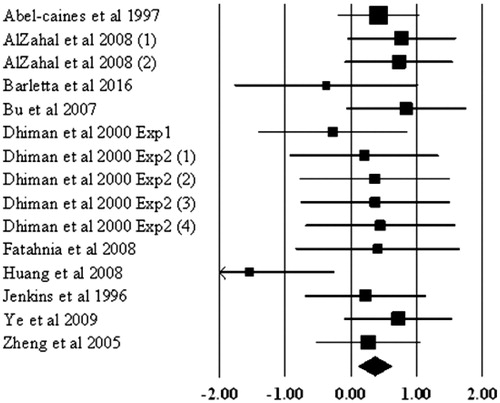
Figure 2. Funnel plot for analysing publication bias of milk production. Empty circles indicate observed values.
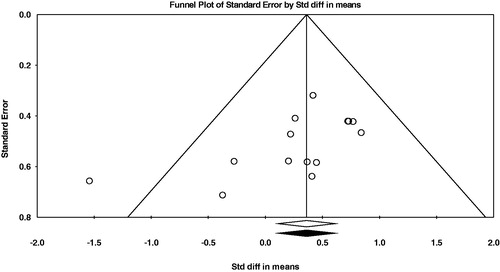
Table 2. Effect size and heterogeneity for the effect of soybean oil on dry matter intake, milk production and milk composition in dairy cows.
Milk composition
Milk fat percentage (p = .001) and MFY (p = .011) are reduced through the addition of soybean oil and heterogeneity results are high (Table , Figures and S2). Table reports the meta-regression analysis for heterogenous variables in the meta-analysis with differences between the control and the soybean oil treatment in: oil dose rate (Dose), total fatty acids (DTFA), C18:2 (D18:2) and diet NDF (DNDF). All variables showed a significant regression for MFP (Dose: p < .003; DTFA: p < .024; D18:2: p < .011; DNDF: p < .027). For MFY all variable except DTFA showed a significant regression (Dose: p < .037; D18:2: p < .047; DNDF: p < .031). No publication bias was found for MFP and MFY (Figure and S5).
Figure 3. Forest plot of the influence of soybean oil on milk fat percentage in milk of dairy cows based on Standardised Mean Differences (SMD). The mean effect size, calculated according to a random effects model, is indicated by the diamond at the bottom. The size of the squares illustrates the weight of each study relative to the mean effect size. Smaller squares represent less weight.
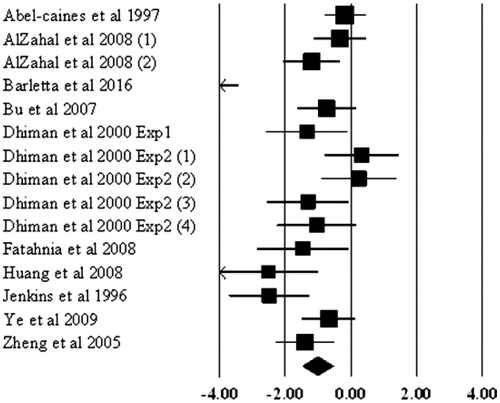
Figure 4. Funnel plot for analysing publication bias of milk fat percentage. Empty circles indicate observed values.
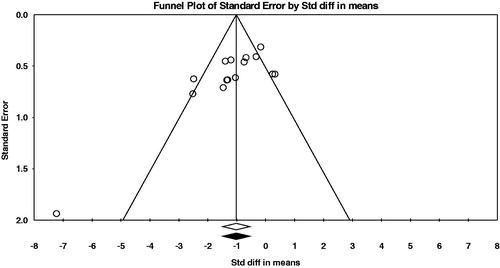
Table 4. Summary of meta-regression analysis.
The meta-analysis shows that MPP decreases (p = .069) whereas milk protein yield (MPY) increases (p = .665) in response to soybean oil inclusion in the diet. MPP was also shown to be heterogenous and was further assessed by meta-regression in Table , although none of the variables were found to be significant and thus causative. To examine the bias in publication, funnel plot (Figure S6) shows that for MPP there are 2 studies on the right side of the plot suggesting publication bias.
No difference was reported for milk lactose percentage (MLP; p = .794) or yield (MLY; p = .933) between control and soybean oil inclusion, with subsequently no heterogeneity in the response (Table ). No publication bias was found for either MLP (Figure S8).
Milk fatty acid profile
The results of the meta-analysis and meta-regression for the effect of supplementing soybean oil to the diets of dairy cows on the composition of milk fatty acids are reported in Tables and , respectively. Soybean oil decreased the short-chain fatty acids (C6:0–C16:0), except for C4:0 (p = .069), of milk. The effect on odd chain fatty acids was similar, although not significant for C17:0 (p = .317). Adding dietary soybean oil significantly increased C18:0 (p < .001) but had no influence on C20:0 (p = .859) in milk. Heterogeneity of short-chain and medium-chain (C4:0–C16:0), odd-chain (C15:0 and C17:0) and long-chain (C18:0 and C20:0) fatty acids was significant. C12:0, C14:0 and C16:0 showed that Dose, DTFA and D18:2 were significant causes of heterogeneity between studies, whereas for C10:0 DTFA was not significant and for C18:0 none of the variables were causative for the heterogeneity observed. Soybean oil had no effect on C18:1 cis-9, whilst C18:1 trans-11 in milk was shown to increase. Adding soybean oil led to an increase in the concentration of C18:2 (p = .007; Figure ), cis-9 trans-11 CLA (p = .018) and trans-10 cis-12 CLA (p = .042) in milk, whereas the increase in C18:3 (p = .401) was not significant. Unsaturated fatty acids, other than C18:3 and trans-10 cis-12 CLA, showed significant heterogeneity. Meta-regression performed on milk C18:2 (with 15 comparisons) showed that Dose was the only variable affecting the heterogeneity observed. By examining funnel plots for publication bias, no bias in the publication for milk fatty acids was observed except for C18:0 (Figure S13) and C18:2 (Figure ).
Figure 5. Forest plot of the influence of soybean oil on C18:2 in milk of dairy cows based on Standardised Mean Differences (SMD). The mean effect size, calculated according to a random effects model, is indicated by the diamond at the bottom. The size of the squares illustrates the weight of each study relative to the mean effect size. Smaller squares represent less weight.
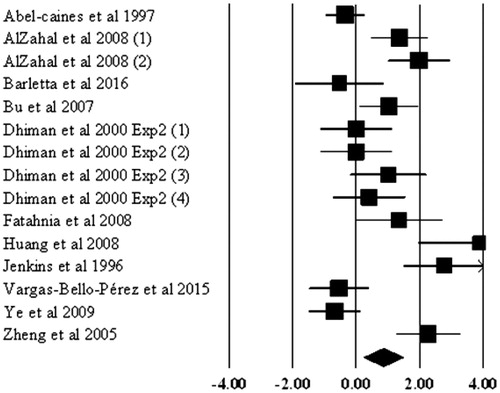
Figure 6. Funnel plot for analysing publication bias of C18:2 in milk. Empty circles indicate observed values and solid dots are the potentially missing studies.
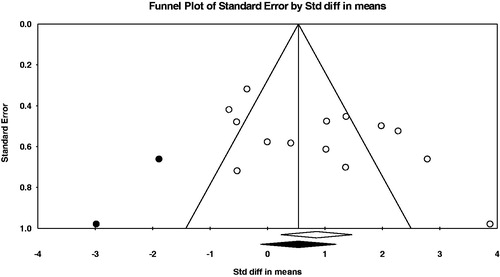
Table 3. Effect size and heterogeneity for the effect of soybean oil on milk fatty acid profiles in dairy cows.
Discussion
Dry matter intake
Our meta-analysis showed DMI was decreased following dietary supplementation with soybean oil to lactating dairy cows. The effect of unsaturated fatty acid supplementation on DMI has been previously reported (Allen Citation2000; Harvatine and Allen Citation2005). This reduction has been associated with the negative effects of unsaturated fatty acids on rumen microorganisms reducing fibre digestibility and subsequently flow rate and fibre digestion from the rumen (Jenkins and Harvatine Citation2014). Some studies have also reported that unsaturated fatty acids increase the CCK (Cholecystokinin) and GLP-1 (glucagon-like peptide 1) activities reducing DMI (Harvatine and Allen Citation2005; Litherland et al. Citation2005; Bradford et al. Citation2008).
Milk yield and composition
Increased MY shown by the meta-analysis, was probably related to rising energy concentration of the diet through supplementation with soybean oil in comparison with the control group. The MFP and MFY decreased by adding soybean oil. Reduction of milk fat because of fat supplements rich in unsaturated fatty acids are well known and have been reviewed previously (Shingfield et al. Citation2013; Jenkins and Harvatine Citation2014). In the study of Dhiman et al. (Citation2000) they reported that higher levels (2% and 4%) of soybean oil inclusion reduced MFP associated with a limitation in the capacity of rumen microorganisms to hydrogenate polyunsaturated fatty acids. In the meta-regression performed to explain the heterogeneity of the MFP response to soybean oil Dose and D18:2 were found to be important explanatory factors, although DNDF was also causative. This suggests a reduction in fibre digestibility and consequently reduction in MFP associated with lower acetate formation in the rumen may also have an effect (Urrutia and Harvatine Citation2017).
Changes in the biohydrogenation of polyunsaturated fatty acids through soybean oil supplementation have been implicated in reducing MFP through formation of trans-10 cis-12 CLA on oil-containing or concentrate rich diets (de Veth et al. Citation2004; Shingfield et al. Citation2013). Trans-10 cis-12 CLA has been shown to down regulate sterol response element binding protein (SREBP-1) which regulates de novo milk fatty acid synthesis in the mammary gland via up regulating a host of fat forming enzymes (Perfield et al. Citation2007; Jenkins and Harvatine Citation2014). Due to a slight increase in MY and high reduction in MFP it was expected that total production of milk fat per day may also be reduced.
In the present meta-analysis, MPP and MPY were not affected by soybean oil. Overall, results of the individual studies for MPP and MPY using fat supplements are contradictory. Dhiman et al. (Citation2000), Zheng et al. (Citation2005) and Huang et al. (Citation2008) all showed no response to soybean oil, whereas Abel-Caines et al. (Citation1998) and AlZahal et al. (Citation2008) reported a reduction. Reduction in MPP when supplementing diets with oil can be associated with negative effects on microbial fermentation in the rumen reducing microbial protein synthesis and subsequent supply at the small intestine (Harvatine and Allen Citation2005). Alternatively, the response could be due to increased milk yield and subsequent, milk protein dilution (Drackley and Elliott Citation1993). However, when protein is adequate in the diet to support level of performance most studies show no negative effect of oil supplementation on milk protein as confirmed with our meta-analysis. The meta-regression for MPP in the current study showed that the heterogeneity of MPP was not affected by Dose, DTFA or D18:2.
Percentage and amount of lactose in the milk was also not affected by supplementation of soybean oil in the diet of dairy cows. In general, milk lactose percentage is one of the most consistent components and is less affected by diet type, which agrees with most studies associated with oil supplements (Baumgard et al. Citation2002). However, some studies reported increased percentage of milk lactose with oil supplementation associated with an increase in glucose, which is the main precursor of milk lactose (Boerman and Lock Citation2014).
Milk fatty acid profile
The meta-analysis showed that dietary supplementation of soybean to lactating dairy cows reduces short and medium chain fatty acids (C6-C16). The negative effects of oil on the rumen microorganisms impairing ruminal fermentation of fibre decreasing acetate formation in the rumen, which is the main precursor for de novo milk fat synthesis of short and medium chain fatty acids in the mammary gland (Griinari and Bauman Citation1999; Urrutia and Harvatine Citation2017). In this meta-analysis it has also been shown that soybean oil increases C18:1 trans-11 and trans-10, cis-12 CLA in milk fat, which have an inhibitory effect on de novo synthesis possibly through the action of the enzyme Acetyl-CoA carboxylase and SREBP-1 (Baumgard et al. Citation2002; Peterson et al. Citation2003). Heterogeneity was observed in relation to short and medium chain fatty acids and further assessed by meta-regression for C10:0, C12:0, C14:0 and C16:0. Dose for all fatty acids and D18:2 for C12:0, C14:0 and C16:0 were found to be the main reasons of heterogeneity. Increasing doses of soybean oil and subsequently C18:2 will also inhibit rumen fermentation and through biohydrogenation increase CLA isomer formation influencing de novo synthesis. The results of the meta-analysis showed that the concentration of C18:0, C18:1 trans-11, C18:2, cis-9 trans-12 CLA and trans-10 cis-12 increased with supplementation of soybean oil because of a greater intake of C18 fatty acids and subsequent formation of biohydrogenation intermediates and saturated end-product in the rumen. (Griinari and Bauman Citation1999; AlZahal et al. Citation2008). Test results of Q and I2 for: C18:0, C18:1 cis-9, C18:1 trans-11, C18:2, cis-9 trans-11 CLA and trans-10 cis-12 CLA suggests the existence of heterogeneity among the studies, unfortunately there were insufficient studies to carry out a meta-regression for these different fatty acids to determine cause. In relation to C18:3 in milk fat the results of the meta-analysis showed that soybean oil supplementation had no significant effect, which, given that the amount of C18:3 is low in soybean oil, is not too surprising.
Conclusions
The meta-analysis has shown that dietary supplementation of soybean oil to lactating dairy cows can reduce DMI, increase milk production with concomitant reduction in milk fat. In general, soybean oil supplements reduce short-chain fatty acids and increase the long chain unsaturated fatty acids in milk fat especially C18:1 trans-11, C18:2 and CLA. Therefore, it can be expected that these effects are observed within dairy products produced in this way for the industry.
Acknowledgements
The authors wish to thank and acknowledge the contributions of Dr Helen M. Golder from Scibus, Australia for the help and insightful advice regarding the statistical analyses.
Disclosure statement
No potential conflict of interest was reported by the authors.
References
- Abel-Caines S, Grant R, Morrison M. 1998. Effect of soybean hulls, soy lecithin, and soapstock mixtures on ruminal fermentation and milk composition in dairy cows. J Dairy Sci. 81:462–470.
- Allen MS. 2000. Effects of diet on short-term regulation of feed intake by lactating dairy cattle. J Dairy Sci. 83:1598–1624.
- AlZahal O, Odongo N, Mutsvangwa T, Or-Rashid M, Duffield T, Bagg R, Dick P, Vessie G, McBride B. 2008. Effects of monensin and dietary soybean oil on milk fat percentage and milk fatty acid profile in lactating dairy cows. J Dairy Sci. 91:1166–1174.
- Barletta RV, Gandra JR, Bettero VP, Araújo CE, Del Valle TA, de Almeida GF, de Jesus EF, Mingoti RD, Benevento BC, de Freitas Júnior JE, et al. 2016. Ruminal biohydrogenation and abomasal flow of fatty acids in lactating cows: oilseed provides ruminal protection for fatty acids. Anim Feed Sci Technol. 219:111–121.
- Baumgard L, Matitashvili E, Corl B, Dwyer D, Bauman D. 2002. Trans-10, cis-12 conjugated linoleic acid decreases lipogenic rates and expression of genes involved in milk lipid synthesis in dairy cows. J Dairy Sci. 85:2155–2163.
- Boerman J, Lock A. 2014. Effect of unsaturated fatty acids and triglycerides from soybeans on milk fat synthesis and biohydrogenation intermediates in dairy cattle. J Dairy Sci. 97:7031–7042.
- Borenstein M, Hedges L, Higgins JP, Rothstein H. 2009. Introduction to meta–analysis. Chichester, UK: John Wiley & Sons.
- Bradford B, Harvatine K, Allen M. 2008. Dietary unsaturated fatty acids increase plasma glucagon-like peptide-1 and cholecystokinin and may decrease premeal ghrelin in lactating dairy cows. J Dairy Sci. 91:1443–1450.
- Bu D, Wang J, Dhiman T, Liu S. 2007. Effectiveness of oils rich in linoleic and linolenic acids to enhance conjugated linoleic acid in milk from dairy cows. J Dairy Sci. 90:998–1007.
- Contò F, Del Nobile MA, Faccia M, Zambrini AV, Conte A. 2017. Advances in dairy products. Hoboken, USA: John Wiley & Sons.
- de Veth MJ, Griinari JM, Pfeiffer A-M, Bauman DE. 2004. Effect of CLA on milk fat synthesis in dairy cows: comparison of inhibition by methyl esters and free fatty acids, and relationships among studies. Lipids. 39:365–372.
- Dhiman T, Satter L, Pariza M, Galli M, Albright K, Tolosa M. 2000. Conjugated linoleic acid (CLA) content of milk from cows offered diets rich in linoleic and linolenic acid. J Dairy Sci. 83:1016–1027.
- Drackley J, Elliott J. 1993. Milk composition, ruminal characteristics, and nutrient utilization in dairy cows fed partially hydrogenated tallow. J Dairy Sci. 76:183–196.
- Duffield T, Rabiee A, Lean I. 2008. A meta-analysis of the impact of monensin in lactating dairy cattle. Part 1. Metabolic effects. J Dairy Sci. 91:1334–1346.
- Fatahnia F, Nikkhah A, Zamiri MJ, Kahrizi D. 2008. Effect of dietary fish oil and soybean oil on milk production and composition of Holstein cows in early lactation. Asian Austral J Anim Sci. 21:386–391.
- Givens D. 2010. Milk and meat in our diet: good or bad for health? Animal. 4:1941–1952.
- Griinari J, Bauman D. 1999. Biosynthesis of conjugated linoleic acid and its incorporation into meat and milk in ruminants. Adv Conjugat Linoleic Acid Res. 1:180–200.
- Harvatine K, Allen M. 2005. The effect of production level on feed intake, milk yield, and endocrine responses to two fatty acid supplements in lactating cows. J Dairy Sci. 88:4018–4027.
- Higgins J, Thompson SG. 2002. Quantifying heterogeneity in a meta-analysis. Stat Med. 21:1539–1558.
- Hiller B. 2014. Recent developments in lipid metabolism in ruminants–the role of fat in maintaining animal health and performance. Anim Produc Sci. 54:1549–1560.
- Huang Y, Schoonmaker J, Bradford B, Beitz D. 2008. Response of milk fatty acid composition to dietary supplementation of soy oil, conjugated linoleic acid, or both. J Dairy Sci. 91:260–270.
- Jenkins T, Bateman H, Block S. 1996. Butylsoyamide increases unsaturation of fatty acids in plasma and milk of lactating dairy cows. J Dairy Sci. 79:585–590.
- Jenkins TC, Harvatine KJ. 2014. Lipid feeding and milk fat depression. Vet Clin Food Anim Pract. 30:623–642.
- Kliem KE, Shingfield KJ. 2016. Manipulation of milk fatty acid composition in lactating cows: opportunities and challenges. Eur J Lipid Sci Technol. 118:1661–1683.
- Lean I, Rabiee A, Duffield T, Dohoo I. 2009. Invited review: use of meta-analysis in animal health and reproduction: methods and applications. J Dairy Sci. 92:3545–3565.
- Litherland N, Thire S, Beaulieu A, Reynolds C, Benson J, Drackley J. 2005. Dry matter intake is decreased more by abomasal infusion of unsaturated free fatty acids than by unsaturated triglycerides. J Dairy Sci. 88:632–643.
- Littell JH, Corcoran J, Pillai V. 2008. Systematic reviews and meta-analysis. New York: Oxford University Press.
- Loor JJ, Quinlan LE, Bandara AB, Herbein JH. 2002. Distribution of trans-vaccenic acid and cis9, trans11-conjugated linoleic acid (rumenic acid) in blood plasma lipid fractions and secretion in milk fat of Jersey cows fed canola or soybean oil. Anim Res. 51:119–134.
- Perfield JW, Lock AL, Griinari JM, Saebø A, Delmonte P, Dwyer DA, Bauman DE. 2007. Trans-9, cis-11 conjugated linoleic acid reduces milk fat synthesis in lactating dairy cows. J Dairy Sci. 90:2211–2218.
- Peterson DG, Matitashvili EA, Bauman DE. 2003. Diet-induced milk fat depression in dairy cows results in increased trans-10, cis-12 CLA in milk fat and coordinate suppression of mRNA abundance for mammary enzymes involved in milk fat synthesis. J Nutr. 133:3098–3102.
- Shingfield K, Bonnet M, Scollan N. 2013. Recent developments in altering the fatty acid composition of ruminant-derived foods. Animal. 7:132–162.
- Siri-Tarino PW, Sun Q, Hu FB, Krauss RM. 2010. Meta-analysis of prospective cohort studies evaluating the association of saturated fat with cardiovascular disease. Am J Clin Nutr. 91:535–546.
- Sutton AJ, Higgins J. 2008. Recent developments in meta-analysis. Stat Med. 27:625–650.
- Urrutia NL, Harvatine KJ. 2017. Acetate dose-dependently stimulates milk fat synthesis in lactating dairy cows. J Nutr. 147:763–769.
- Vargas-Bello-Pérez E, Fehrmann-Cartes K, Íñiguez-González G, Toro-Mujica P, Garnsworthy P. 2015. Short communication: chemical composition, fatty acid composition, and sensory characteristics of Chanco cheese from dairy cows supplemented with soybean and hydrogenated vegetable oils. J Dairy Sci. 98:111–117.
- Ye J, Wang C, Wang H, Ye H, Wang B, Liu H, Wang Y, Yang Z, Liu J. 2009. Milk production and fatty acid profile of dairy cows supplemented with flaxseed oil, soybean oil, or extruded soybeans. Acta Agri Scand Section A. 59:121–129.
- Zheng H, Liu J, Yao J, Yuan Q, Ye H, Ye J, Wu Y. 2005. Effects of dietary sources of vegetable oils on performance of high-yielding lactating cows and conjugated linoleic acids in milk. J Dairy Sci. 88:2037–2042.
